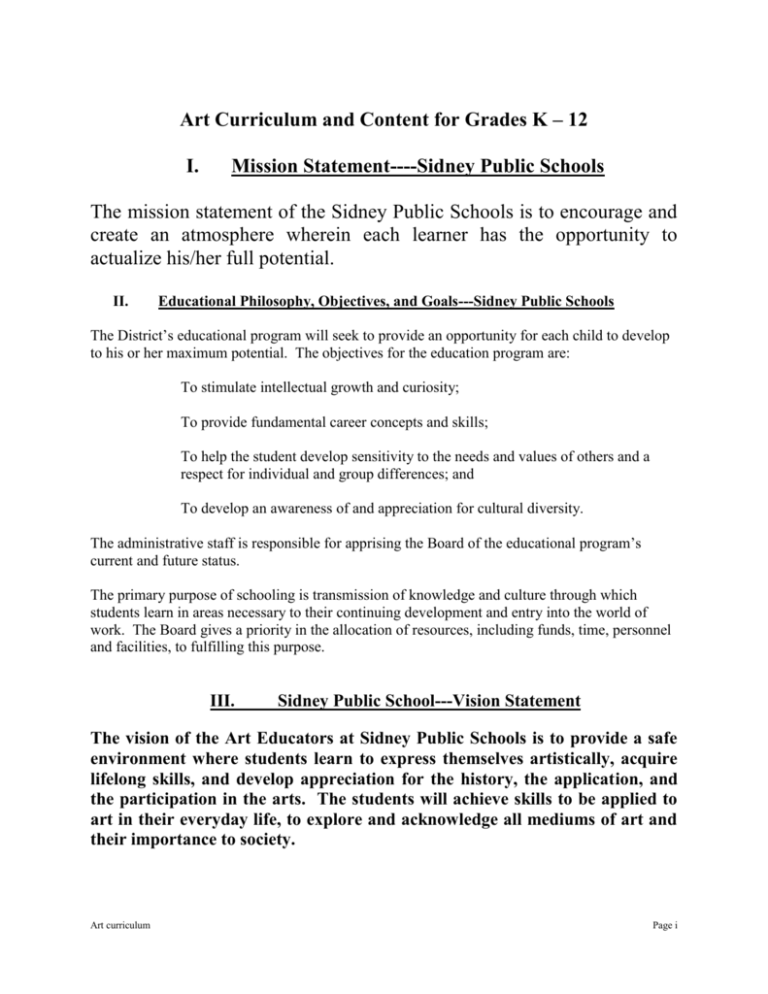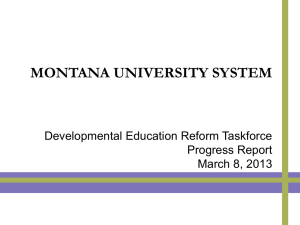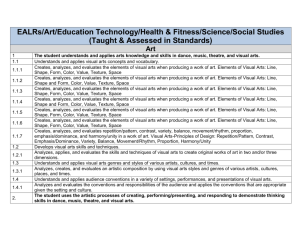Art Curriculum 2009
advertisement

Art Curriculum and Content for Grades K – 12 I. Mission Statement----Sidney Public Schools The mission statement of the Sidney Public Schools is to encourage and create an atmosphere wherein each learner has the opportunity to actualize his/her full potential. II. Educational Philosophy, Objectives, and Goals---Sidney Public Schools The District’s educational program will seek to provide an opportunity for each child to develop to his or her maximum potential. The objectives for the education program are: To stimulate intellectual growth and curiosity; To provide fundamental career concepts and skills; To help the student develop sensitivity to the needs and values of others and a respect for individual and group differences; and To develop an awareness of and appreciation for cultural diversity. The administrative staff is responsible for apprising the Board of the educational program’s current and future status. The primary purpose of schooling is transmission of knowledge and culture through which students learn in areas necessary to their continuing development and entry into the world of work. The Board gives a priority in the allocation of resources, including funds, time, personnel and facilities, to fulfilling this purpose. III. Sidney Public School---Vision Statement The vision of the Art Educators at Sidney Public Schools is to provide a safe environment where students learn to express themselves artistically, acquire lifelong skills, and develop appreciation for the history, the application, and the participation in the arts. The students will achieve skills to be applied to art in their everyday life, to explore and acknowledge all mediums of art and their importance to society. Art curriculum Page i IV. PREFACE The primary aim of this curriculum document is to establish content coverage and a plan for instructional delivery and assessment that leads to artistic literacy for each student. Consequently, teachers are critical to the vision developed by the art curriculum committee. The curriculum committee, with the assistance of educators throughout the district, endeavors to provide students with the opportunity to learn about and understand the world in which they live. A special note of thank you to: Janet MacDonald---Educator Bill Clark----Educator Daniel Farr------Curriculum Director Kelly Johnson----Administrator V. INTRODUCTION Development of this document was based on the Montana School Accreditation Standards (2001) and the national standards for art. Classroom curriculum, as defined by Marzano (2003), is the “sequencing and pacing of content along with the experiences students have with that content” (p. 106). Breakdowns in student learning are more often the result of poor alignment and sequencing of content. Phase I of the curriculum design process focused on alignment of grade level content with the grade level content standards. Phase II of this project focused on curriculum pacing, the development of standardized guides for the delivery and assessment of content. Phase III involves the implementation and refining of this document by K – 12 teachers. Montana has defined standards and benchmarks in all subject areas. Standards and benchmarks may be accessed at www.metnet.state.mt.us. Established content standards describe what a student should know and be able to do at grades 4, 8, and upon high school graduation. In essence, students must achieve a high level of subject matter competence (Proficient) with respect to each content area. Each student’s mastery is determined by his or her performance on state mandated tests. The State of Montana has organized student scores, as measured by state mandated tests. Unlike core content areas, there are no state mandated tests for Art Education. However, proficiency levels are defined as: NOVICE (Stanines 1-3): Students beginning to attain the prerequisite knowledge and skills fundamental for that subject matter. NEARING PROFICIENCY (Stanine 4): Students with partial mastery of prerequisite knowledge and skills fundamental for that subject matter. PROFICIENT (Stanines 5-7): Students demonstrating competency over the subject matter including subject matter knowledge, application of such knowledge to real world situations, and the analytical skills appropriate to the subject matter. Art curriculum Page ii ADVANCED (Stanines 8-9): Students achieving a superior mastery of the subject matter. MONTANA ACCREDITATION STANDARDS FOR THE ARTS Student exposure to the four art disciplines—dance, music, theatre, and the visual arts provides several benefits with respect to individual development and the greater society to which we all belong. Engagement in the arts fosters self-discipline, higher self-esteem, thinking skills, creativity, reasoning, imagination and greater understanding of the world around us. The curriculum that follows focuses on the visual arts and the other mediums are met through courses and experiences that include music, physical education, and co-curricular programs afforded students. The importance of Art Education is echoed in this statement from the Consortium of National Arts Education Associations: The educational success of our children depends on creating a society that is both literate and imaginative, both competent and creative. That goal depends, in turn, on providing children with tools not only for understanding that world but for contributing to it and making their own way. Without the arts to help shape students' perceptions and imaginations, our children stand every chance of growing into adulthood as culturally disabled. We must not allow that to happen. Source: National Standards for Art Education. http://www.ed.gov/pubs/ArtsStandards.html The Montana standards that follow provide emphasis on what students should know and be able to do and it is recommended that all students become proficient in at least one of the four art disciplines. The following standards served as the foundation for curriculum work completed. Content Standard 1—Students create, perform/exhibit, and respond in the Arts. Content Standard 2—Students apply and describe the concepts, structures, and processes in the Arts. Content Standard 3—Students develop and refine arts skills and techniques to express ideas, pose and solve problems, and discover meaning. Content Standard 4—Students analyze characteristics and merits of their work and the work of others. Content Standard 5—Students understand the role of the Arts in society, diverse cultures, and historical periods. Content Standard 6—Students make connections among the Arts, other subject areas, life, and work. Art curriculum Page iii The following Arts Performance Standards describe advanced student achievement levels or superior performance levels for grade 4, 8, and upon graduation). These benchmarks profile the students’ knowledge, skills and abilities in the Arts content area on a continuum from kindergarten through grade twelve. Additionally, these descriptions are profile the highest levels of achievement sought for all students. Grade 4 Arts: Advanced A fourth-grade student at the advanced level in the Arts demonstrates superior performance. He/she: (a)independently creates, performs/exhibits in and responds through a minimum of one art form; (b) consistently applies, with confidence, the concepts, structures and processes in the four art forms of Dance, Music, Theatre, and Visual Arts; (c) uses a variety of skills and techniques to express ideas and poses and solves problems in the Arts; (d) independently practices responsible, safe and appropriate personal and group behavior in the Arts; (e) analyzes the characteristics and merits of their work and the works of others in the Arts; (f) consistently recognizes and respects the role of the Arts in his/her society, diverse cultures, and historical periods; and (g) consistently finds and shares multiple connections among the Arts, other subject areas and life. Grade 8 Arts: Advanced An eighth-grade student at the advanced level in the Arts demonstrates superior performance. He/she: (a) effectively creates, performs/exhibits in and responds through more than one art form; (b) consistently applies with confidence concepts, structures and processes in the four art forms of Dance, Music, Theatre and Visual Arts; (c) applies a variety of skills and techniques to effectively express ideas and to pose and solve problems in the Arts; (d) independently practices responsible, safe and appropriate personal and group behavior in the Arts; (e) evaluates the characteristics and merits of his/her work and the works of others in the Arts ; (f) effectively and consistently analyzes the role of the Arts in his/her society, diverse cultures, and historical periods; and (g) synthesizes and evaluates connections among the Arts, other subject areas, life, and work. Art curriculum Page iv Upon Graduation Arts: Advanced A graduating student at the advanced level in the Arts demonstrates superior performance. He/she: (a) creates, performs/exhibits and responds through more than one art form at an accomplished level; (b) consistently applies, analyzes and interprets the concepts, structures and processes in the four art forms of Dance, Music, Theatre and Visual Arts; (c) distinguishes and analyzes appropriate skills and techniques to effectively express ideas and to pose and solve problems in the Arts; (d) independently practices responsible, safe and appropriate personal group behavior in the Arts; (e) accepts responsibility for the characteristics and merits of their works and appreciates the works of others in the Arts; (f) effectively and consistently analyzes and evaluates the role of the Arts in his/her society, diverse cultures, and historical periods; and (g) synthesizes and evaluates connections among the Arts, other subject areas, life, and work. Source: Montana Office of Public Instruction-Accreditation Standards “The artist is a receptacle for emotions that come from all over the place; from the sky, from the earth, from a scrap of paper, from a passing shape, from a spider’s web.” Spanish Artist- Pablo Picasso Art curriculum Page v







